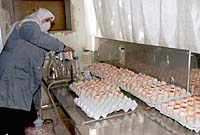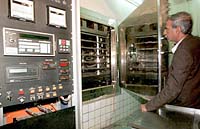

Scott Peterson, Staff writer of The Christian Science Monitor
BAGHDAD, IRAQ --

|
| UNDER SURVEILLANCE: An Iraqi woman
uses eggs for tests last week at an animal-vaccine factory under United Nations
observation in Abu Ghraib, west of Baghdad. Iraqi officials organized tours
of several facilities. (JASSIM MOHAMMED/AP/POOL) |
But overhead, three United Nations video cameras record every movement. They were put in place by the UN Special Commission (UNSCOM), which is charged with dismantling Iraq's nuclear, chemical, and biological weapons, and the missiles to deliver them.
The cameras send images to the UN in Baghdad by microwave, ensuring that the factory is not making mass-destruction weapons.
Progess on even closer inspections has shot forward. UN Secretary-General Kofi Annan signed a breakthrough agreement with the Iraqi government yesterday, defusing a standoff over inspector access to "presidential sites." And he has said he expects the deal to be acceptable to the United States.
Of real significance for Mr. Annan's deal - if it holds - will be the preservation of UNSCOM's monitoring system, built up across Iraq over seven years. Its work has destroyed far more of Iraq's weapons capability than the entire 42-day air campaign of the Gulf War.
|
'Nothing is functioning now. They destroyed everything.' - Iraqi worker on tour of UN-closed factory |
But the fragility of that system is made clear during a rare visit to this factory, one of several still under constant UN surveillance.
Facilitating the visit, Iraqi officials sought to show how they have cooperated with inspectors.
"They are sure that we don't do any prohibited activities," says Shaker Hamed Rayiss, a senior official of Iraq's National Monitoring Directorate. "For sure they spent a lot of money on this monitoring system, but of course this would be destroyed completely [if bombing starts]. It is the best example of such a system in the region, and for the future."
A 'sensitive' site?
A mammoth Boldrini press for stamping out
pieces of heavy metal equipment stands at one end of the factory, rebuilt
after damage done to it during a 1991 bombing raid.
But by comparison, the little UNSCOM control box - where the cameras are connected to the microwave panel on the roof - looks humbly small. Its door is protected only by a thin plastic UNSCOM seal. Even the electric plug is taped into the socket with black electrical tape. A protective wire-mesh housing, which the Iraqis say they built, prevents any "accidents."
During the last crisis in November, Iraq blocked UNSCOM from inspecting certain sites it deemed "sensitive," and expelled American inspectors. At the time - again under the threat of US military attack - Iraq tampered with UN cameras at some locations, blocking their view, and moved some equipment to "protect" it from possible strikes.
But even as this factory is kept under surveillance, the scene at Iraq's General Establishment for Animal Development illustrates another aspect of UNSCOM's work. These laboratories produced 1 million veterinary vaccines every year, but benign as that purpose may have been, weapons inspectors found this nondescript site a rich target.
In the field, UNSCOM is backed by one of the most intrusive UN mandates in history. Visitors to this site are met by a camera on the roof, which watches any activity in the parking lot.
'Nothing is functioning'
This site was not targeted by allied
air bombardments in 1991, but if US and British aircraft were to strike Iraq
again there would be no need to hit this place: UNSCOM has already made sure
that it will not produce anything potentially usable for the production of
biological weapons again.

|
| RARE LOOK: Iraqi worker displays refrigerators
during media tour of factory outside Baghdad. An agreement with Iraq forged
by UN head Kofi Annan appears set to open more disputed sites to UN inspectors.
(JASSIM MOHAMMED/AP/POOL) |
Inside the main chamber, a visitor first trips the UNSCOM motion detector, which activiates another camera on the wall so that UNSCOM can keep an eye on all visitors.
The two 690-gallon fermentation vats - considered to be "dual use" because the same process used for making the vaccines is used to create deadly biological warfare spores - have been removed completely.
The walls are blackened where Iraqi workers hired by UNSCOM first bent, broke, and cut all piping systems for heating and cooling units with hammers and crowbars, and then irreparably melted them with a blow torch.
Two centrifuges - also "dual use" items - are still intact in the middle of the floor, but tagged with numbered UNSCOM stickers so they can be traced if moved.
|
And in case there was any doubt that UNSCOM never wants this place used again, hardening foam was pumped throughout the ventilation system, and capped with concrete. The yellow goo oozes out of the ventilation ducts in the ceiling.
Untouched in darkened rooms are large urns full of dusty glass laboratory equipment, jars for samples, and racks of flasks and slender pipettes. A faded portrait of Saddam Hussein in military dress is taped to an abandoned laboratory cupboard.
One odorous storeroom is packed with old chemicals and assumed to be non-dangerous because UNSCOM has left them untouched. UNSCOM biological inspectors come once a month, the Iraqis say, and technicians come as often to check the UNSCOM seals on the cameras and change videotapes.
Missing warheads
UNSCOM says it has dismantled all of Iraq's once-formidable
nuclear program, has found all but two of its 819 Scud missiles, and is making
continuous progress on the chemical weapon portfolio.
Still unaccounted for, though, are 45 "special warheads" believed to be filled with chemical and biological agents. The extent of Iraq's nerve gas program is still unknown, and UNSCOM says that Iraq's latest "full, final, and complete disclosure" document has "serious flaws."
"UNSCOM is working hard on these things," says Nils Carlstrom, the UNSCOM director in Baghdad.
"We've done a lot of work, and hopefully we will be able to go on and finish."